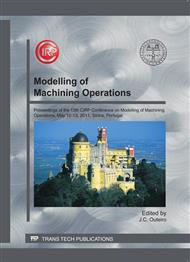p.182
p.191
p.203
p.212
p.222
p.231
p.240
p.247
p.257
Simulation of the Temperature Distribution in NC-Milled Workpieces
Abstract:
In most cases the simulation of temperature distributions in machined workpieces is carried out by moving a heat source along a predefined workpiece model within a commercial FEM-system. For performance reasons, the material removal is often neglected or performed by removing small predefined parts of the workpiece. Furthermore, the heat source often has a constant heat flux and therefore it is not dependent on the current tool engagement. In this paper we present a voxel-based finite difference method for the thermal behavior of the process-state dependent workpiece, which is integrated into the milling simulation system NCChip, developed at the ISF. This simulation is capable of modeling the cutting forces along any arbitrary NC-path. Since the tool rotation and the cutting edges in this time domain simulation are divided into discrete angle steps and cutting wedges respectively, the thermal energy that is applied to the workpiece at each time step and at each cutting wedge can be computed as a fraction of the corresponding cutting work. In this way, the correct heat is introduced to the workpiece exactly at the current contact zone of the tool.
Info:
Periodical:
Pages:
222-230
Citation:
Online since:
April 2011
Keywords:
Price:
Сopyright:
© 2011 Trans Tech Publications Ltd. All Rights Reserved
Share:
Citation:


